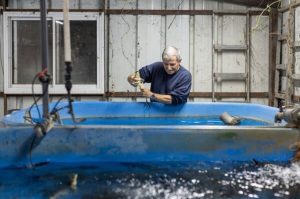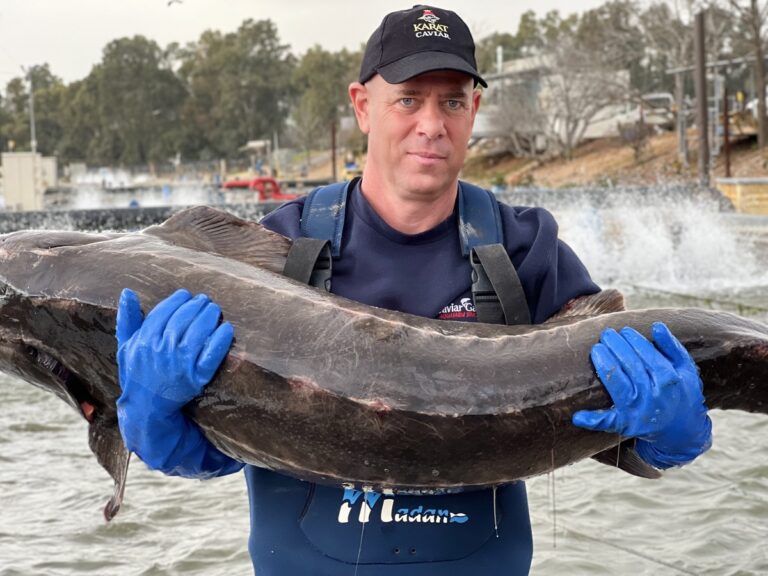Shrapnel and Sturgeon: Making Caviar Under the Rockets in Israel
The war with Hezbollah has cleared out the north of the country — save for a hardy few and their thousands of prized fish.
On The photo: Assaf Koren, the head of Caviar Galilee, a fish farm in Kibbutz Dan, Israel, in November.Credit…Avishag Shaar-Yashuv for The New York Times
By Jack Nicas
Jack Nicas traveled to the Israel-Lebanon border to speak with caviar producers. He also joined them in taking shelter from Hezbollah fire.
Dec. 28, 2024
Shrapnel kept turning up in the fish pools. The twisted metal had been falling from the sky for 14 months, detritus of Hezbollah rockets and Israeli missile interceptors colliding overhead.
There was not much the fish farm’s workers could do, other than pick it out and soldier on. The war had largely emptied the rolling hills along Israel’s border with Lebanon, but about a dozen farmers had stayed put.
The fish — 50,000 female osetra sturgeon gliding back and forth in 39 pools — had to be fed.
“Every morning I ask myself if this is the right thing to do — to ask the employees to come in again and again,” Assaf Koren, the fish farm’s boss, said recently, between constant booms of outgoing and incoming rockets, just before a cease-fire was reached. “But,” he added, “we don’t have any other choice.”
Why? Those sturgeon carried the ovaries that promised a decade’s worth of caviar. Once extracted, salted and shipped off to places like New York, Los Angeles, Paris and Tokyo, the eggs could be worth upward of $40 million. “We must continue,” Mr. Koren said, a pistol tucked into his pants.
So, three weeks earlier, when Mr. Koren watched a Hezbollah rocket blow off the steel door of the factory at Caviar Galilee, spraying shrapnel and igniting a truck, everyone returned to work the next morning. The fish had to be fed.

The rocket strike at Caviar Galilee sprayed shrapnel across a sign for the farm’s flagship product, branded Karat Caviar.Credit…Avishag Shaar-Yashuv for The New York Times
The latest war between Israel and Hezbollah chased more than 60,000 people from their homes and businesses in northern Israel — and displaced one million across Lebanon. After the two sides agreed to a cease-fire, some residents are trickling back, while many others are staying away until it is clear the fragile peace will hold.
But in pockets along the border, a small number never left. For some, it was an act of defiance. Others felt they had no place to go. And then there were the few with immense economic stakes.
At Caviar Galilee, protecting a decade’s worth of investment requires not missing a day. To produce the caviar, the workers must follow the calendar of the sturgeon ovulation cycle, adjusting the pools’ temperature and oxygen levels and feeding the fish three times a day. And they must do so, without fail, for at least nine years, until the precise moment when the eggs are ready to harvest.
So the first Hezbollah attacks on Oct. 8, 2023, posed an immediate dilemma for Mr. Koren and his team. When Israel issued evacuation orders for the region, Mr. Koren, 47, sent his wife and four children south. Then he and Avshalom Hurvitz, the farm’s 76-year-old fish biologist, stayed behind with the sturgeon.

Avshalom Hurvitz, the farm’s 76-year-old fish biologist, holding a sturgeon at the farm. “Fish, when they are in stressful conditions, do not want to reproduce,” he said.Credit…Avishag Shaar-Yashuv for The New York Times
“You can’t just shut the electricity down and come back a year later,” Dr. Hurvitz said. “These are animals. They have to be taken care of every day, including weekends. No Shabbat for the fish.”
“So,” he added, “we take the risk.”
Eventually, 10 to 15 other employees took the risk, too, while another dozen moved away. For 416 days, the farm — a collection of fish pools, hatcheries and a caviar-harvesting plant in a valley between Lebanon and Syria — was directly in the crossfire. It is just a mile from the border with Lebanon, where Hezbollah fighters were launching rockets and drones, and a few hundred yards from an Israeli military post that was firing back.
During the war, Mr. Koren said he started each day with a call to the Israeli military. On a few occasions, when fighting was particularly intense, they asked him to pause work for a few hours. Mr. Koren is a longtime army veteran. “It’s better not to speak about that,” he said.
He left the army five years ago to lead Caviar Galilee. He had experience in gourmet food, investing years ago in a truffle business, and the fish farm was just down the hill from his home.
To him, transitioning from fighting to fish farming made sense. “Both are forms of Zionism,” he said. Zionists believe that farming helps Jewish people set roots in Israel.

Fish ponds at the farm. Caviar Galilee is a collection of pools, hatcheries and a caviar-harvesting plant in a valley between Lebanon and Syria.Credit…Avishag Shaar-Yashuv for The New York Times
As he drove his white Dodge Ram up an empty road to his kibbutz, a small community based on shared farming, there were signs of war everywhere. The surrounding hills were blackened, the aftermath of brush fires started by wayward rockets. The kibbutz entrances were watched by armed guards, one of whom was recently hit by shrapnel in his chest. And the community pool was full of a green algae bloom, while the nearby lookout point over the valley was covered in sandbags propped up for sniper positions.
Mr. Koren, impatient with the war, brought his family home several months ago. That meant regular family retreats to the bomb shelter.
On the day we met, Mr. Koren said a siren warning of incoming rockets awoke his family in the middle of the night. At breakfast, he said, another siren sent them racing to the shelter. Less than an hour later in our conversation, a siren sent us running for an aboveground shelter the size of a walk-in closet that the farm had recently bought. After a boom in the distance, we exited.

Female sturgeon in a pond. The farm is just a mile from the border with Lebanon, where Hezbollah fighters were launching rockets and drones, and a few hundred yards from an Israeli military post that was firing back. Credit…Avishag Shaar-Yashuv for The New York Times
In Tel Aviv, residents usually have more than a minute to take shelter after the sirens sound because of the distance rockets must travel from Lebanon. Here along the border, people have a few seconds.
It has made for a stressful workplace — and a stressful home for the fish.
Dr. Hurvitz said stress increases hormones like cortisol and glucose in sturgeon. “And these hormones affect the physiology of the fish,” he said. “Fish, when they are in stressful conditions, do not want to reproduce. They want to conserve energy for better days.”
Dr. Hurvitz said that typically about half of the fish expected to ovulate have caviar-grade eggs. This season, just a tenth did, which he attributes to the stress of the constant vibrations from the explosions.
Caviar Galilee, a multimillion-dollar enterprise, is owned by socialists. Six kibbutzim — small communities founded on socialist ideals, where residents share the work and spoils of collective farms — founded the operation in the 1990s. They made it a private company and agreed to share its now hefty profits.

A sample of sturgeon eggs ready for transfer to a test tube before being sent to the farm’s laboratory.Credit…Avishag Shaar-Yashuv for The New York Times
With half the shares, the principal owner is Kibbutz Dan, where the farm is, along a tributary of the Jordan River. The 60-degree spring waters flowing from Mount Hermon in Syria are ideal for raising fish, Dr. Hurvitz said, so residents of the kibbutz have farmed fish for generations.
In the early 1990s, the kibbutz saw an opportunity: Caviar prices were soaring in the aftermath of the collapse of the Soviet Union. So the kibbutz started raising sturgeon for their eggs. It shipped its first caviar about 15 years later.
Now those eggs, sold under the brand Karat Caviar, are a favorite of Michelin Star restaurants, including Le Bernardin and Daniel in Manhattan. Virtually all caviar is now farmed, after a global ban on fishing sturgeon in the Caspian Sea, and China’s entry into the market in recent years has doubled world production. Yet demand still often outstrips supply. Mr. Koren said that this year, all of his company’s caviar had sold while still inside the fish.
Caviar Galilee now produces roughly six tons of caviar a year, which it sells at up to $500 a pound to wholesalers. End consumers can pay as much as $3,600 a pound. For some varieties of caviar, a one-ounce tin — enough for about three servings — costs $225.
Americans buy 65 percent of its product. The next largest market is Israel, though many Israelis are not potential customers.
Caviar is not kosher.

A display refrigerator with caviar containers.Credit…Avishag Shaar-Yashuv for The New York Times
Gabby Sobelman contributed reporting.




